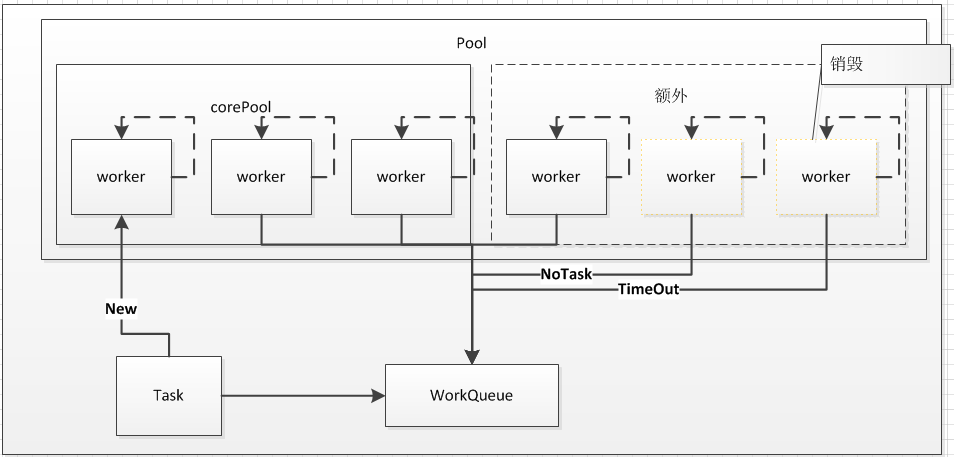 ?
?class="java" name="code">public void execute(Runnable command) { if (command == null) throw new NullPointerException(); //poolSize大于等于corePoolSize时不增加线程,反之新初始化线程 if (poolSize >= corePoolSize || !addIfUnderCorePoolSize(command)) { //线程执行状态外为执行,同时可以添加到队列中 if (runState == RUNNING && workQueue.offer(command)) { if (runState != RUNNING || poolSize == 0) ensureQueuedTaskHandled(command); } //poolSize大于等于corePoolSize时,新初始化线程 else if (!addIfUnderMaximumPoolSize(command)) //无法添加初始化执行线程,怎么执行reject操作(调用RejectedExecutionHandler) reject(command); // is shutdown or saturated } }
private final class Worker implements Runnable {
/**
* Runs a single task between before/after methods.
*/
private void runTask(Runnable task) {
final ReentrantLock runLock = this.runLock;
runLock.lock();
try {
/*
* If pool is stopping ensure thread is interrupted;
* if not, ensure thread is not interrupted. This requires
* a double-check of state in case the interrupt was
* cleared concurrently with a shutdownNow -- if so,
* the interrupt is re-enabled.
*/
//当线程池的执行状态为关闭等,则执行当前线程的interrupt()操作
if ((runState >= STOP ||
(Thread.interrupted() && runState >= STOP)) &&
hasRun)
thread.interrupt();
/*
* Track execution state to ensure that afterExecute
* is called only if task completed or threw
* exception. Otherwise, the caught runtime exception
* will have been thrown by afterExecute itself, in
* which case we don't want to call it again.
*/
boolean ran = false;
beforeExecute(thread, task);
try {
//任务执行
task.run();
ran = true;
afterExecute(task, null);
++completedTasks;
} catch (RuntimeException ex) {
if (!ran)
afterExecute(task, ex);
throw ex;
}
} finally {
runLock.unlock();
}
}
/**
* Main run loop
*/
public void run() {
try {
hasRun = true;
Runnable task = firstTask;
firstTask = null;
//判断是否存在需要执行的任务
while (task != null || (task = getTask()) != null) {
runTask(task);
task = null;
}
} finally {
//如果没有,则将工作线程移除,当poolSize为0是则尝试关闭线程池
workerDone(this);
}
}
}
/* Utilities for worker thread control */
/**
* Gets the next task for a worker thread to run. The general
* approach is similar to execute() in that worker threads trying
* to get a task to run do so on the basis of prevailing state
* accessed outside of locks. This may cause them to choose the
* "wrong" action, such as trying to exit because no tasks
* appear to be available, or entering a take when the pool is in
* the process of being shut down. These potential problems are
* countered by (1) rechecking pool state (in workerCanExit)
* before giving up, and (2) interrupting other workers upon
* shutdown, so they can recheck state. All other user-based state
* changes (to allowCoreThreadTimeOut etc) are OK even when
* performed asynchronously wrt getTask.
*
* @return the task
*/
Runnable getTask() {
for (;;) {
try {
int state = runState;
if (state > SHUTDOWN)
return null;
Runnable r;
if (state == SHUTDOWN) // Help drain queue
r = workQueue.poll();
//当线程池大于corePoolSize,同时,存在执行超时时间,则等待相应时间,拿出队列中的线程
else if (poolSize > corePoolSize || allowCoreThreadTimeOut)
r = workQueue.poll(keepAliveTime, TimeUnit.NANOSECONDS);
else
//阻塞等待队列中可以取到新线程
r = workQueue.take();
if (r != null)
return r;
//判断线程池运行状态,如果大于corePoolSize,或者线程队列为空,也或者线程池为终止的工作线程可以销毁
if (workerCanExit()) {
if (runState >= SHUTDOWN) // Wake up others
interruptIdleWorkers();
return null;
}
// Else retry
} catch (InterruptedException ie) {
// On interruption, re-check runState
}
}
}
/**
* Performs bookkeeping for an exiting worker thread.
* @param w the worker
*/
//记录执行任务数量,将工作线程移除,当poolSize为0是则尝试关闭线程池
void workerDone(Worker w) {
final ReentrantLock mainLock = this.mainLock;
mainLock.lock();
try {
completedTaskCount += w.completedTasks;
workers.remove(w);
if (--poolSize == 0)
tryTerminate();
} finally {
mainLock.unlock();
}
}
?
线程保有量,线程池总永久保存执行线程的数量
最大线程量,线程最多不能超过此属性设置的数量,当大于线程保有量后,会新启动线程来满足线程执行。
获取队列中任务的超时时间,当阈值时间内无法获取线程,则会销毁处理线程,前提是线程数量在corePoolSize?以上
执行队列是针对任务的缓存,任务在提交至线程池时,都会压入到执行队列中。所以这里大家最好设置下队列的上限,防止溢出
?
?
public static ExecutorService newCachedThreadPool() { return new ThreadPoolExecutor(0, Integer.MAX_VALUE, 60L, TimeUnit.SECONDS, new SynchronousQueue<Runnable>()); }
public static ExecutorService newSingleThreadExecutor() {
return new FinalizableDelegatedExecutorService
(new ThreadPoolExecutor(1, 1,
0L, TimeUnit.MILLISECONDS,
new LinkedBlockingQueue<Runnable>()));
}
public static ExecutorService newFixedThreadPool(int nThreads) {
return new ThreadPoolExecutor(nThreads, nThreads,
0L, TimeUnit.MILLISECONDS,
new LinkedBlockingQueue<Runnable>(),
threadFactory);
}
?
?